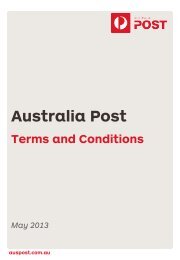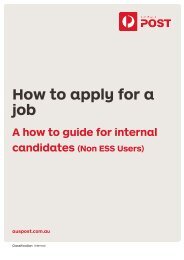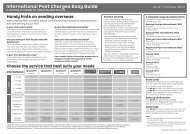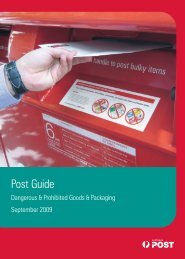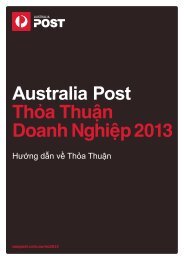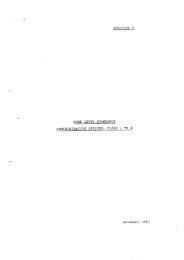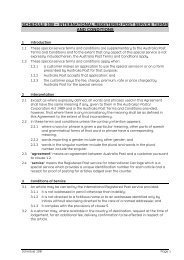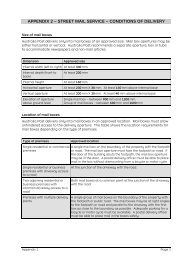2009-10 Annual Report - Australia Post
2009-10 Annual Report - Australia Post
2009-10 Annual Report - Australia Post
Create successful ePaper yourself
Turn your PDF publications into a flip-book with our unique Google optimized e-Paper software.
notes to And ForminG PArt oF the FinAnCiAl rePort For the year ended 30 June 20<strong>10</strong><br />
(m) derivative financial instruments and hedging<br />
the group uses derivative financial instruments (including forward<br />
currency contracts, oil swap contracts and interest rate swaps) to<br />
hedge its risks associated with interest rate, foreign currency and<br />
oil/diesel price fluctuations. such derivative financial instruments<br />
are initially recognised at fair value on the date on which a derivative<br />
contract is entered into and are subsequently remeasured to fair value.<br />
derivatives are carried as assets when their fair value is positive and<br />
as liabilities when their fair value is negative.<br />
any gains or losses arising from changes in the fair value of derivatives,<br />
except for those that qualify as cashflow hedges, are taken directly to<br />
net profit or loss for the year.<br />
derivative assets and liabilities are classified as non-current when the<br />
remaining maturity is more than 12 months or as current when the<br />
remaining maturity is less than 12 months.<br />
the fair value of non-optional derivatives is determined based on<br />
discounted cashflow analysis using the applicable yield curve or forward<br />
curve (currency or commodity) for the duration of the instrument.<br />
For the purposes of hedge accounting, hedges are classified as:<br />
• fair value hedges when they hedge the exposure to changes in<br />
the fair value of a recognised asset or liability or unrecognised<br />
firm commitments;<br />
• cashflow hedges when they hedge exposure to variability in<br />
cashflows that is attributable either to a particular risk associated<br />
with a recognised asset or liability or to a highly probable forecast<br />
transaction; or<br />
• hedges of a net investment in a foreign operation (the group does<br />
not currently have such hedges in place).<br />
hedges that meet the strict criteria for hedge accounting are accounted<br />
for as follows:<br />
(i) Fair value hedges<br />
Fair value hedges are hedges of the group’s exposure to changes in<br />
the fair value of a recognised asset or liability or an unrecognised firm<br />
commitment, or an identified portion of such an asset, liability or firm<br />
commitment, that is attributable to a particular risk and could affect<br />
profit or loss. For fair value hedges, the carrying amount of the hedged<br />
item is adjusted for gains and losses attributable to the risk being<br />
hedged, the derivative is remeasured to fair value and gains and<br />
losses from both are taken to profit or loss.<br />
the group discontinues fair value hedge accounting if the hedging<br />
instrument expires or is sold, terminated or exercised, the hedge no<br />
longer meets the criteria for hedge accounting or the group revokes<br />
the designation. any adjustment to the carrying amount of a hedged<br />
financial instrument for which the effective interest method is used<br />
is amortised to profit or loss. amortisation may begin as soon as an<br />
adjustment exists and shall begin no later than when the hedged<br />
item ceases to be adjusted for changes in its fair value attributable<br />
to the risk being hedged.<br />
(ii) Cashflow hedges<br />
cashflow hedges are hedges of the group’s exposure to variability<br />
in cashflows that is attributable to a particular risk associated with<br />
a recognised asset or liability or a highly probable forecast transaction<br />
that could affect profit or loss.<br />
the effective portion of the gain or loss on the hedging instrument is<br />
recognised directly in equity, while the ineffective portion is recognised<br />
in profit or loss. amounts taken to equity are transferred out of equity<br />
and included in the measurement of the hedged transaction when the<br />
forecast transaction occurs.<br />
52<br />
AustrAliA <strong>Post</strong> AnnuAl rePort <strong>2009</strong>–<strong>10</strong> | Financial and statutory reports<br />
For cashflow hedges if the risk is over-hedged, the ineffective portion<br />
is taken immediately to other income/expense in the statement of<br />
comprehensive income.<br />
if the forecast transaction is no longer expected to occur, amounts<br />
previously recognised in equity are transferred to the statement of<br />
comprehensive income. if the hedging instrument expires or is sold,<br />
terminated or exercised without replacement or rollover, or if its<br />
designation as a hedge is revoked, amounts previously recognised<br />
in equity remain in equity until the forecast transaction occurs.<br />
(n) Foreign currency translation<br />
(i) Functional and presentation currency<br />
Both the functional and presentation currency of the corporation and its<br />
australian subsidiaries is australian dollars ($). each entity in the group<br />
determines its own functional currency and items included in the financial<br />
statements of each entity are measured using that functional currency.<br />
(ii) transactions and balances<br />
transactions in foreign currencies are initially recorded in the functional<br />
currency by applying the exchange rates ruling at the date of the transaction.<br />
Monetary assets and liabilities denominated in foreign currencies are<br />
retranslated at the rate of exchange ruling at the reporting date.<br />
non-monetary items that are measured in terms of historical cost in a<br />
foreign currency are translated using the exchange rate as at the date<br />
of the initial transaction. non-monetary items measured at fair value in<br />
a foreign currency are translated using the exchange rates at the date<br />
when the fair value was determined.<br />
(iii) translation of group companies functional currency to<br />
presentation currency<br />
the results of the overseas subsidiaries are translated into australian<br />
dollars as at the date of each transaction. assets and liabilities are<br />
translated at exchanges rates prevailing at balance date.<br />
on consolidation, exchange differences arising from the translation of<br />
the net investment in overseas subsidiaries are taken to the foreign<br />
currency translation reserve. if an overseas subsidiary were sold, the<br />
proportionate share of exchange differences would be transferred out<br />
of equity and recognised in the statement of comprehensive income.<br />
(o) investment in jointly controlled entities<br />
the group’s investments in jointly controlled entities are accounted<br />
for using the equity method of accounting in the consolidated financial<br />
statements and at cost less any impairment loss in the corporation’s<br />
financial statements. Jointly controlled entities are entities where<br />
decisions regarding the financial and operating policies essential to<br />
the activities, economic performance and financial position of that<br />
venture require the consent of each of the venturers that together<br />
jointly control the entity.<br />
under the equity method, the investment in the jointly controlled entity<br />
is carried in the consolidated balance sheet at cost plus post-acquisition<br />
changes in the group’s share of net assets of the jointly controlled<br />
entities. Goodwill relating to a jointly controlled entity is included<br />
in the carrying amount of the investment and is not amortised.<br />
after application of the equity method, the group determines whether<br />
it is necessary to recognise any additional impairment loss with respect<br />
to the group’s net investment in the jointly controlled entities. Goodwill<br />
included in the carrying amount in the investment in jointly controlled<br />
entities is not tested separately; rather, the entire carrying amount<br />
of the investment is tested for impairment as a single asset. if an<br />
impairment is recognised, the amount is not allocated to the goodwill<br />
of the jointly controlled entity.




